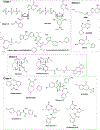Biochemical pharmacology of adenylyl cyclases in cancer
- PMID: 38522554
- PMCID: PMC11410551
- DOI: 10.1016/j.bcp.2024.116160
Biochemical pharmacology of adenylyl cyclases in cancer
Abstract
Globally, despite extensive research and pharmacological advancement, cancer remains one of the most common causes of mortality. Understanding the signaling pathways involved in cancer progression is essential for the discovery of new drug targets. The adenylyl cyclase (AC) superfamily comprises glycoproteins that regulate intracellular signaling and convert ATP into cyclic AMP, an important second messenger. The present review highlights the involvement of ACs in cancer progression and suppression, broken down for each specific mammalian AC isoform. The precise mechanisms by which ACs contribute to cancer cell proliferation and invasion are not well understood and are variable among cancer types; however, AC overactivation, along with that of downstream regulators, presents a potential target for novel anticancer therapies. The expression patterns of ACs in numerous cancers are discussed. In addition, we highlight inhibitors of AC-related signaling that are currently under investigation, with a focus on possible anti-cancer strategies. Recent discoveries with small molecules regarding more direct modulation AC activity are also discussed in detail. A more comprehensive understanding of different components in AC-related signaling could potentially lead to the development of novel therapeutic strategies for personalized oncology and might enhance the efficacy of chemoimmunotherapy in the treatment of various cancers.
Keywords: Adenylyl Cyclase; Cancer; G protein; GPCR; Hallmarks of Cancer; cAMP signaling.
Copyright © 2024 Elsevier Inc. All rights reserved.
Conflict of interest statement
Declaration of competing interest The authors declare that they have no known competing financial interests or personal relationships that could have appeared to influence the work reported in this paper.
Figures





References
-
- Hanahan D, Weinberg RA, Hallmarks of cancer: the next generation, Cell 144(5) (2011) 646–74. - PubMed
Publication types
MeSH terms
Substances
Grants and funding
LinkOut - more resources
Full Text Sources
Medical

